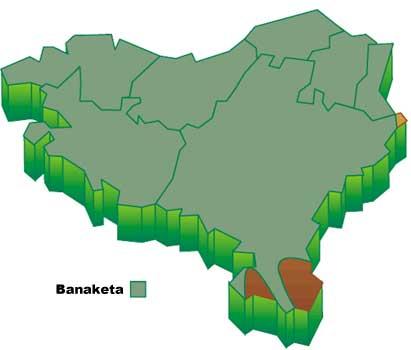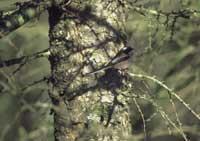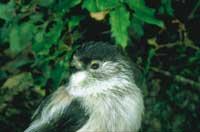Keeping the rock more original...

Clayey, is a feather pelotite attached to a very long tail. It has an approximate length of 14 cm and if we consider that more than half is of tail, we have an epotxa of 6-7 cm of length and 7-9 grams of weight. Besides being a small body, with very short legs and peaks, the famous tail of this peculiar bird seems longer. It is clear, therefore, that the most outstanding feature of this bird is the abnormal length of the tail or tail, which makes it almost unmistakable. We have said almost unmistakable, because potters (of the genus Motacilla) also have a very long tail and therefore can be confusing. But they are also very different in size, march, coloration, place of residence and other characteristics, so we can easily distinguish each other.
This passerine, on the other hand, is dressed in striking feathers of white, black colors and throats: tail, head and whitish fins; whitish belly and ribs throats. It should be noted that throughout Europe this species presents forms of variable coloration, such as those of the north of the continent, with white head.

When not zealous, the long mud is a gregarious animal that likes to go in a gang. It is part of the groups formed by births and other small birds that travel through the forests. However, despite greed, amilotxas, refractories, birds, etc., we can easily distinguish the length of the tail. In the first place and as we have said, its clay is spectacular in any position, and, on the other hand, the usual noise that brings out so as not to disperse the group is also separable from the rest of species, when sharpening the ear: We will hear a kind of “tsirrrp”.
In these groups of birds of different species, the long clays usually form groups of 8 or 15 specimens that move successively along the forest in traditional routes. After spending the whole day together, at night all the members of the species come together to sleep. Thus, a branch of trees is chosen and the whole group meets very well to warm up.
The day passes from the tree to the tree, in the hunt for chomorras, small spiders, vegetable leaves, etc. In this endeavor they work very intensively, and we can often see them in the most acrobats positions when it comes to detecting bad limbs. It should be noted that, like few birds, mattresses can eat pine harvest, so they help combat these pests.
As spring arrives, groups dissolve and begin to pair in pairs to reproduce. It seems that the females leave the group and look for the other groups, which serves them to avoid consanguinity. After wedding flights, the couple starts building the nest. It is noteworthy the nest that these chorizos make, along with that made the txepetxes, one of the most cultivated in the area. Skilfully using moss, spider webs, lichens and feathers, they form a large, capricious and round nest.

Although construction requires a few days of hard work, the end result is very beautiful. The walls are wrapped inside with sweet feathers and, to get the camouflage, cover the outside with spiders. The entrance is located on one side or on the top. The nest is placed on some of the hidden branches of a tree or bush and usually not very tall. Apparently, among the trees that choose to install the nest, the cigar is one of the most appreciated.
In the coming days the female lays between 8 and 12 white eggs stained with red. Chickens are born after two weeks of incubation and are able to leave the nest in another 14-18 days if everything goes well. Unfortunately, it is not always like this and as nests often break, it can be said that at that time many specimens die.
In any case, keeping the circle of friendships more original, the long clays that have lost the chiton have a special behavior. Like most species, if they are at the beginning of the reproductive age, they try to get a new chitazo. However, if the shape is advanced, they show a very curious behavior: they go to some nest in the neighborhood and join their parents to help them get ahead their little ones. Those who have children will understand well that between 3-4 people can grow better than between 2 famines 8-12. This surprising attitude, moreover, is not something that happens from time to time, since in most couples you can see another length of mud working with parents.

After the release of the chickens from the nest, until young people learn to use themselves, help is maintained. Because the mattresses normally take out two chituras, it is common for a couple to be in the nest with the milestones of the second round and that all the offspring of the previous round are asking forage around the nest. In these narrow situations, of course, the species that approach aid make a great benefit.
In Euskal Herria the long potter is a common nesting agent. As for its habitat, it appears in forest areas, scrubland and open bushes, preferring hardwood forests to conifers. Above 1,000-1,200 meters, it is difficult to climb, so we will not find ourselves in the Pyrenees and in the rest of the high mountains. On the other hand, as it does not like the cleared lands, it does not appear in some places of the Ribera area. He lives in Europe and Asia worldwide and, in general, has not much tendency to migrate.
Finally, we will mention two sources of death of these cheerful and lively birds. On the one hand, they are passionate insectivores and, as with many animals that have this power supply, chemicals such as insecticides cause a great impact. On the other hand, they are quite weak and have difficulty facing the harsh winter. Presumably in the snow this year our friends have seen red.
Species: Aegithalos caudatus |





